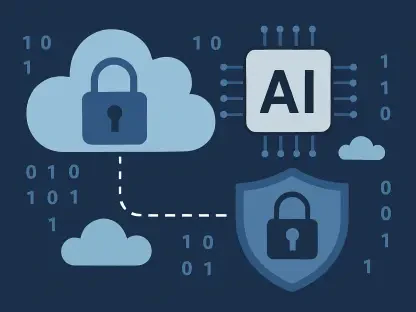In an era where cyber threats loom larger than ever, the financial toll of data breaches remains a pressing concern for organizations worldwide, with recent findings shedding light on both promising solutions and escalating challenges. A comprehensive report on breach costs reveals a notable decline in the average expense of a data breach, dropping from a staggering high to a more manageable $4.44 million this year. This reduction signals the impact of innovative security practices that are reshaping how companies protect their digital assets. However, as supply chain complexities grow, they introduce new vulnerabilities that drive up costs and test the resilience of even the most prepared entities. The interplay between cutting-edge strategies like DevSecOps, which significantly lowers expenses, and persistent issues such as third-party risks, paints a nuanced picture of the cybersecurity landscape. This dynamic underscores the urgent need for organizations to adapt swiftly to evolving threats while balancing innovation with robust risk management.
Harnessing DevSecOps for Cost Reduction
The adoption of DevSecOps has emerged as a game-changer in mitigating the financial impact of data breaches, offering a proactive approach that integrates security into every phase of the development lifecycle. By fostering collaboration among development, security, and operations teams, this methodology emphasizes automation, continuous monitoring, and rigorous testing to identify and address vulnerabilities before they can be exploited. The result is a significant cost saving, with organizations employing DevSecOps shaving off an average of $227,192 per breach. This approach not only enhances the speed of detection and response but also minimizes the window of opportunity for attackers, reducing potential damage. As companies increasingly shift toward agile and iterative development processes, embedding security from the ground up proves to be a critical factor in maintaining a strong defense against cyber incidents, ultimately protecting both data and bottom lines from severe financial repercussions.
Beyond the immediate savings, DevSecOps contributes to a cultural shift within organizations, prioritizing security as a shared responsibility rather than an afterthought. This mindset helps dismantle silos that often hinder effective communication between teams, ensuring that potential risks are flagged and resolved early in the development pipeline. Additionally, the use of automated tools within this framework streamlines compliance with regulatory standards, further cutting down on penalties that can arise from breaches. The ripple effect of such integration is evident in faster incident response times, which directly correlate with lower costs associated with downtime and recovery efforts. As cyber threats continue to evolve in sophistication, the structured yet flexible nature of DevSecOps equips companies to stay ahead of adversaries, reinforcing the idea that prevention is not just better but also far more economical than a cure in the realm of cybersecurity.
Leveraging AI for Enhanced Security Outcomes
Artificial Intelligence (AI) and Machine Learning (ML) are proving to be powerful allies in the fight against data breaches, delivering substantial cost reductions through advanced detection and response capabilities. These technologies enable organizations to sift through vast amounts of data to pinpoint at-risk assets and accelerate containment efforts, resulting in an average saving of $223,503 per incident. The precision of AI-driven insights allows for quicker identification of anomalies that might indicate a breach, thereby shortening the lifecycle of an attack. With a reported 9% global decrease in breach costs attributed to such tools, the value of predictive analytics and automated threat hunting becomes undeniable. Companies that harness these innovations gain a competitive edge, not only in safeguarding sensitive information but also in minimizing the financial fallout when incidents do occur, highlighting the transformative potential of tech-driven security.
However, the benefits of AI come with a caveat, as improper implementation or lack of governance can turn this asset into a liability, inflating breach costs by nearly $193,511 in some cases. A significant portion of organizations—around 13%—have encountered breaches linked to AI, with the vast majority tied to inadequate access controls. The rise of shadow AI, where employees use unsanctioned tools without oversight, further complicates matters, adding an average of $200,321 to expenses due to poor visibility. Despite 20% of companies experiencing breaches from such unregulated usage, only 37% have policies in place to manage this risk. This gap in preparedness reveals a critical need for robust frameworks to govern AI adoption, ensuring that its deployment enhances rather than undermines security efforts. Balancing innovation with control remains a pivotal challenge for organizations aiming to capitalize on AI’s potential without exposing themselves to unintended vulnerabilities.
Navigating the Rising Threat of Supply Chain Breaches
Supply chain breaches stand out as a formidable challenge, significantly driving up the cost of data breaches by an average of $227,244 per incident, due to their indirect and often elusive nature. These attacks frequently involve compromised hardware or software from third-party vendors, making them harder to detect and resolve compared to direct breaches. The complexity of tracing the origin of such incidents often delays resolution by an average of 26 days, amplifying both financial and operational damage. As global supply networks expand and interdependencies grow, the attack surface widens, leaving organizations vulnerable to cascading effects from a single point of failure. Addressing this issue demands a reevaluation of vendor risk management practices and the implementation of stringent monitoring to ensure that every link in the chain adheres to robust security standards, mitigating the risk of costly disruptions.
Compounding the problem is the inherent difficulty in maintaining visibility across sprawling supply ecosystems, where diverse technologies and varying security postures among partners create gaps that attackers can exploit. The financial burden is exacerbated by the need for extensive investigations and the potential for regulatory fines when breaches occur through third-party channels. Organizations must invest in collaborative frameworks that promote transparency and accountability with suppliers, integrating real-time threat intelligence to preemptively identify risks. Beyond immediate costs, supply chain breaches can erode customer trust and damage brand reputation, leading to long-term revenue losses. Tackling this escalating threat requires a holistic approach, where proactive vetting, continuous assessment, and shared responsibility form the bedrock of a resilient defense strategy, ensuring that vulnerabilities in external partnerships do not translate into internal crises.
Addressing Complexities in Security Systems
The complexity of security systems represents another significant driver of breach costs, increasing expenses by an average of $207,914 due to the challenges of managing diverse and often disjointed technologies. Overloaded with excessive data and intricate configurations, these systems can obscure critical threats, prolonging the time needed to detect and respond to incidents. This delay not only extends the breach lifecycle but also escalates costs related to investigation, recovery, and potential regulatory penalties. Simplified architectures and streamlined processes are essential to counteract this issue, enabling security teams to focus on actionable insights rather than sifting through noise. As organizations scale their digital operations, prioritizing integration over patchwork solutions becomes a linchpin for maintaining efficiency and reducing the financial impact of cyber incidents in an increasingly sophisticated threat landscape.
Moreover, the burden of complexity often stems from legacy systems that fail to align with modern security demands, creating friction in threat management and response workflows. The resulting inefficiencies can lead to missed alerts or false positives, draining resources and diverting attention from genuine risks. To combat this, companies should pursue consolidation of security tools and invest in platforms that offer unified visibility across environments. Such measures not only cut down on operational overhead but also enhance the ability to correlate data for faster decision-making during a crisis. The hidden cost of complexity lies in its capacity to undermine even well-funded security programs, making simplification a strategic imperative. By focusing on cohesive systems that prioritize clarity and speed, organizations can better position themselves to handle breaches without incurring exorbitant expenses tied to prolonged resolution and business disruption.
Paving the Way Forward with Strategic Insights
Reflecting on the landscape of data breach costs, it becomes evident that strategic approaches like DevSecOps and AI have carved a path toward substantial savings, curbing financial losses through proactive and automated security measures. Supply chain vulnerabilities and system complexities, however, pose persistent obstacles, inflating expenses with their intricate and often hidden risks. Organizations that embrace integrated practices and maintain sharp visibility over their ecosystems see reduced impacts from cyber incidents. Looking ahead, the focus should shift to actionable steps such as strengthening vendor partnerships with rigorous security protocols and adopting governance policies to manage emerging technologies like AI. Simplifying security architectures also stands as a critical move to enhance response efficiency. By investing in these areas, companies can build resilience against evolving threats, ensuring that the balance tips toward prevention and cost control rather than reaction and recovery in the face of future challenges.









